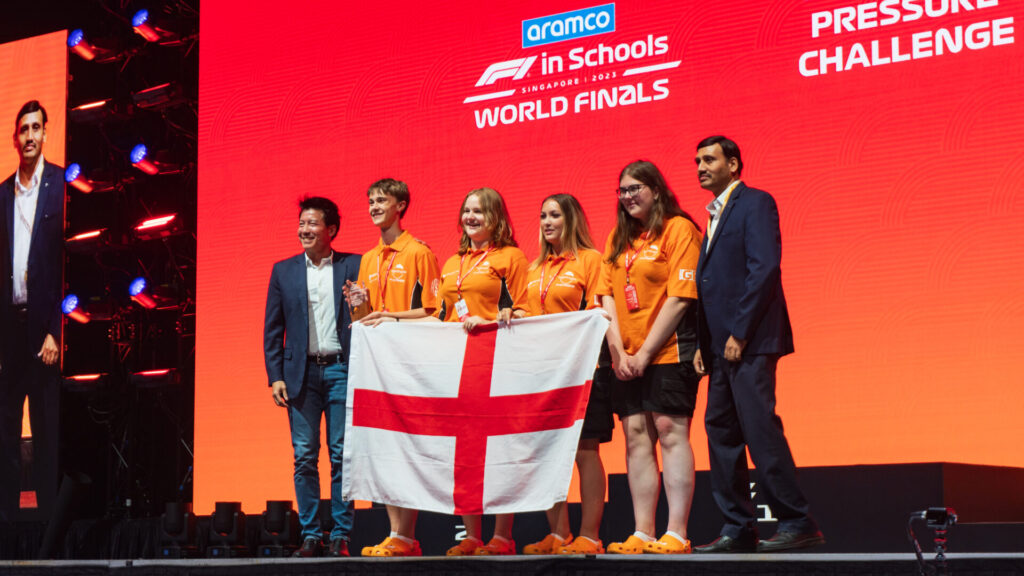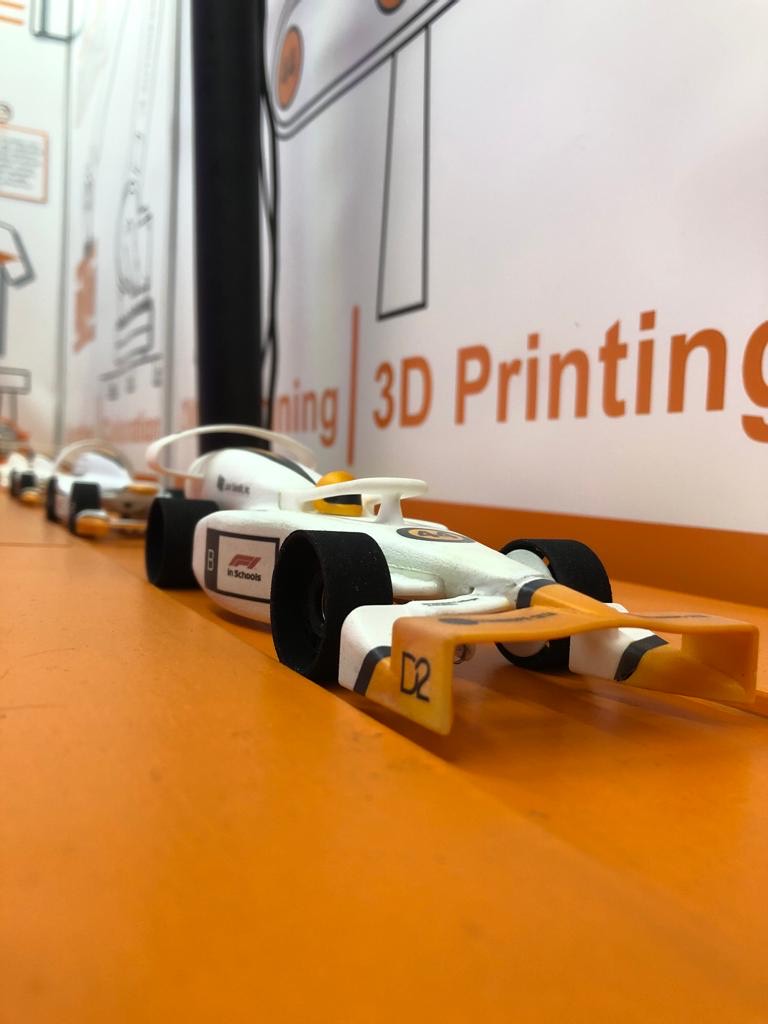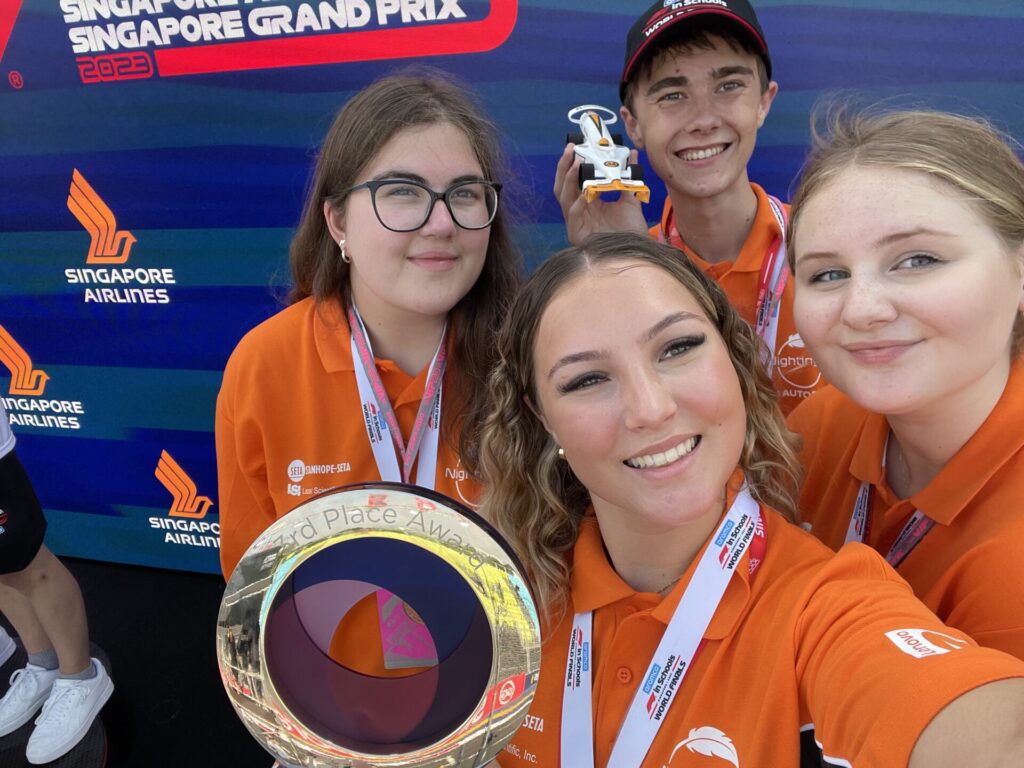& Construction

Integrated BIM tools, including Revit, AutoCAD, and Civil 3D
& Manufacturing

Professional CAD/CAM tools built on Inventor and AutoCAD
5 min read
F1 in Schools provides a fun, exciting STEM experience for students to learn design and engineering. See how Autodesk Fusion helped one team achieve its award-winning goals.
Incredible. Life-changing. Once-in-a-lifetime experience. That’s just a few of the ways Amber Mylrea, 17, and Alistair Horobin, 17, of Team Nightingale from the United Kingdom described their experience at the F1 in Schools World Finals 2023 in Singapore.
Out of 68 teams competing from 26 countries, Team Nightingale took home an impressive third-place finish and won the Autodesk Pressure Challenge award.
“Honestly, we couldn’t have imagined anything better,” says Mylrea, student and project manager for Team Nightingale. “Getting onto the podium was just something in our dreams. The entire event was so inspiring because all the teams there came together for this one common goal—to do the best we can and learn from each other.”

Over the course of the year, F1 in Schools’ STEM curriculum includes a detailed set of guidelines, mandatory components, and technical regulations down to the millimeter to build a miniature F1 car. More than 26,000 schools in 56 countries take part. Autodesk provides all participants with free access to Autodesk Fusion.
Student teams come together to design and manufacture a race car that’s not much longer than your hand, measuring 200mm (about 7.87 in) in length and powered by an 8g compressed gas bottle. But don’t let the small size fool you. The intricacies of engineering, simulation, analysis, modeling, and iterating new designs are huge. There’s even a lesson in finance as teams raise their own money and land sponsors to travel to regional, national, and world finals.
While there is the thrill of seeing these cars zoom down the track, it’s not just about the fastest car at the Aramco F1 in Schools World Finals. All aspects of design and engineering are considered with cumulative points in five different categories: design, analyze, make, test, and project management. There’s even a presentation component where teams create a detailed, printed 10-page portfolio to showcase their research and work along with a live, 10-minute formal presentation.
Team Nightingale has used Autodesk Fusion from start to finish. The five-person team was first formed in 2019. Along with Mylrea and Horobin, lead engineer Harriet Quarmby and enterprise coordinator Charlotte Smith round out the team. Over time, the team’s name has changed and a few members have come and gone. But the core group has remained intact. Their fortitude and passion to improve and learn—even during the pandemic—is a testament to their success.
They’ve gone from winning regional events to placing third in the UK National Finals last year. It’s an achievement that saw them qualify for the Aramco F1 in Schools 2023 World Finals in Singapore where they secured a spot on the podium by coming third out of an incredible 68 teams.
Horobin is the CAD and design engineer for Team Nightingale. In addition to team manager Mylrea, he is a founding member of the team. He learned Fusion from scratch and continues to explore new aspects of the software.
“We could increase the efficiency to iterate the designs, and it helped so much when it came to developing the car,” Horobin says. “Without the access and help from Autodesk, I think our car would look very different from what it is today.”

Freeform modeling in Fusion is one of his favorite parts of the software. This year, the team used it to join the car’s front wing to the main body and create the side pods for an incredibly aerodynamic shape of the car’s body. “What I really like about freeform modeling in Fusion is that it’s easy to iterate with, and you can create really intricate and aerodynamic models,” he says.
“As the official CAD/CAM/CAE partner to F1 in Schools, Autodesk provides all participants in the challenge with free access to its Fusion software, which is a fantastic benefit for students to have. In having access to an industrial-grade product that is both intuitive and easy to use, they can develop their CAD skills, reach their design goals, and gain invaluable experience.”
—Nelson Vale, Head of International Operations, F1 in Schools
Team Nightingale decided to take a closer look at the wheel system and find new sources of inspiration. With Fusion, they optimized the wheels with generative design and created an incredibly unique, organic design to reach their goals.

“If we could decrease the mass of the wheel, we could decrease the energy lost through rotational inertia and this would allow our car to reach higher speeds,” Horobin says. “Our goal was to make these wheels as light as possible and still allow them to carry on spinning without the internal structure failing. The wheel system is such an improvement from the National Finals, and that allowed the car to be a lot faster than we expected it to be.”
The team also used Autodesk CFD to simulate racing to gain virtual insights into the airflow and drag of different designs. Every component of the car had three designs that were tested. Three prototypes of the design were placed in a state-of-the-art wind tunnel at Imperial College London. The resulting data was imported into Autodesk CFD to reduce issues.
“Going to Singapore and connecting with teams from across the globe was an outstanding experience. We saw all our work over the past four years come to light. All these little things fell into place, and it was magical. We’d never raced the latest iteration on a 20-meter track. Seeing it go down the track was just incredible.”
—Amber Mylrea, student and project manager, Team Nightingale
Mylrea and Horobin are soon moving on to university. Their experience with F1 in Schools and learning Fusion has made a direct impact on their future. Mylrea would like to pursue design or project management in engineering and Horobin is looking toward a career in aeronautical or mechanical engineering.
But they aren’t leaving F1 in Schools in the rearview mirror. The rules state that a team can only compete while in school. So, they’re both set to begin their own involvement in judging competitions, including the UK National Finals.

“We had such an incredible experience,” Mylrea says. “Next year it will be time for someone else to have a go.”
Guess what? You can experience F1 in Schools at Autodesk University 2023, happening in Las Vegas from November 13-15. F1 in Schools and Autodesk will bring the thrill of the competition and education opportunities straight to the Expo. Don’t miss the hands-on chance to build your own F1 car and race it down the track.
By clicking subscribe, I agree to receive the Fusion newsletter and acknowledge the Autodesk Privacy Statement.
Success!
May we collect and use your data?
Learn more about the Third Party Services we use and our Privacy Statement.May we collect and use your data to tailor your experience?
Explore the benefits of a customized experience by managing your privacy settings for this site or visit our Privacy Statement to learn more about your options.